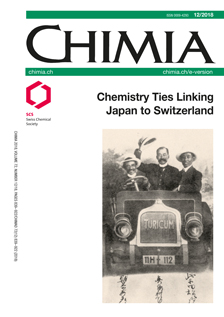Joining Nanotubes Comprising Nucleobase-carrying Amphiphilic Polypeptides
DOI:
https://doi.org/10.2533/chimia.2018.842PMID:
30648948Keywords:
Adenine, Amphiphilic polypeptide, Molecular assembly, Nanotube, ThymineAbstract
Three kinds of amphiphilic polypeptides, X-poly(sarcosine)-b-(L-Leu-Aib)6 (X = adenine, thymine, glycolic acid), were synthesized and self-assembled in a tris buffer to take on nanotube morphology. The nanotubes were joined together to extend the nanotube length with the addition of trifluoroethanol and heat treatment at 50 °C for 24 h. The length extension rate decreased in the order of adenine > glycolic acid > thymine depending on the N-terminal chromophores. Adenine–adenine interactions between the nanotubes were found to be more prevalent upon joining the nanotubes than adenine–thymine interactions. Further, adenines on the nanotube surface could chelate with Cu(ii) to thermodynamically stabilize the nanotube membrane. AFM imaging in liquid environment revealed that the membrane elasticity of the adenine nanotube was as high as ca. 1 MPa, which is considered to be strengthened as a result of the adenine–adenine interactions.Downloads
Published
2018-12-19
Issue
Section
Scientific Articles
License
Copyright (c) 2018 Swiss Chemical Society

This work is licensed under a Creative Commons Attribution-NonCommercial 4.0 International License.
How to Cite
[1]
T. Itagaki, Y. Ueda, K. Itabashi, H. Uji, S. Kimura, Chimia 2018, 72, 842, DOI: 10.2533/chimia.2018.842.







